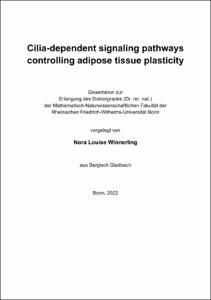Winnerling, Nora Louise: Cilia-dependent signaling pathways controlling adipose tissue plasticity. - Bonn, 2022. - Dissertation, Rheinische Friedrich-Wilhelms-Universität Bonn.
Online-Ausgabe in bonndoc: https://nbn-resolving.org/urn:nbn:de:hbz:5-68692
Online-Ausgabe in bonndoc: https://nbn-resolving.org/urn:nbn:de:hbz:5-68692
@phdthesis{handle:20.500.11811/10435,
urn: https://nbn-resolving.org/urn:nbn:de:hbz:5-68692,
author = {{Nora Louise Winnerling}},
title = {Cilia-dependent signaling pathways controlling adipose tissue plasticity},
school = {Rheinische Friedrich-Wilhelms-Universität Bonn},
year = 2022,
month = nov,
note = {Primary cilia serve as cellular antennae that detect extracellular signals and transduce this information into an intracellular response. Dysfunction of primary cilia leads to a range of severe diseases, i.e., the Bardet-Biedl-Syndrome (BBS). BBS patients and knockout (KO) mouse models display obesity as a cardinal feature. It is known that loss of BBS protein function alters the ciliary protein repertoire, which in turn disrupts ciliary function. Obesity in BBS is primarily caused by primary cilia dysfunction in hypothalamic neurons, leading to hyperphagia. However, data from obese Bbs-KO mice revealed paradoxical higher insulin sensitivity and glucose tolerance compared to control obese mice, which has been attributed to enhanced differentiation of pre- adipocytes. The ability of pre-adipocytes to undergo adipogenesis is crucial to maintain white adipose tissue (WAT) homeostasis during obesity by shifting the expansion towards hyperplasia. Interestingly, adipogenesis has been shown to be cilia- dependent. Thus, ciliary dysfunction on pre-adipocytes might contribute to the obesity phenotype in BBS.
To elucidate the role of primary cilia in WAT, I analyzed the obesity phenotype of different ciliopathy mouse models and investigated pre-adipocyte function and fate. Conditional ablation of cilia attenuated WAT development in vivo, while conditional loss of adenylyl cyclase 3 (AC3) in pre-adipocytes and global loss of BBS8 resulted in severe obesity. In contrast, loss of BBS6 only showed an effect challenged with high fat diet (HFD). This highlights the crucial role of primary cilia for WAT plasticity and indicates distinct functions of different BBS proteins. My results demonstrate that Bbs8- /- mice prior to obesity development showed impaired glucose handling, which, however, did not aggravate further during obesity development and was even improved in comparison to diet-induced obesity. Surprisingly, this was not associated with an increase in adipogenesis. In contrast, Bbs6-/- and conditional AC3-KO mouse models, both, displayed severe glucose intolerance. Additionally, I revealed specific changes in the fate of pre-adipocytes in Bbs8-/- cells already before the onset of obesity, indicating that BBS proteins fulfill specific functions in controlling WAT homeostasis.
To further analyze the underlying molecular causes and functional consequences, I established a sorting strategy to isolate different pre-adipocyte subpopulations to perform transcriptomic and functional analyses and, thereby, unravel the molecular consequence of loss of BBS proteins.},
url = {https://hdl.handle.net/20.500.11811/10435}
}
urn: https://nbn-resolving.org/urn:nbn:de:hbz:5-68692,
author = {{Nora Louise Winnerling}},
title = {Cilia-dependent signaling pathways controlling adipose tissue plasticity},
school = {Rheinische Friedrich-Wilhelms-Universität Bonn},
year = 2022,
month = nov,
note = {Primary cilia serve as cellular antennae that detect extracellular signals and transduce this information into an intracellular response. Dysfunction of primary cilia leads to a range of severe diseases, i.e., the Bardet-Biedl-Syndrome (BBS). BBS patients and knockout (KO) mouse models display obesity as a cardinal feature. It is known that loss of BBS protein function alters the ciliary protein repertoire, which in turn disrupts ciliary function. Obesity in BBS is primarily caused by primary cilia dysfunction in hypothalamic neurons, leading to hyperphagia. However, data from obese Bbs-KO mice revealed paradoxical higher insulin sensitivity and glucose tolerance compared to control obese mice, which has been attributed to enhanced differentiation of pre- adipocytes. The ability of pre-adipocytes to undergo adipogenesis is crucial to maintain white adipose tissue (WAT) homeostasis during obesity by shifting the expansion towards hyperplasia. Interestingly, adipogenesis has been shown to be cilia- dependent. Thus, ciliary dysfunction on pre-adipocytes might contribute to the obesity phenotype in BBS.
To elucidate the role of primary cilia in WAT, I analyzed the obesity phenotype of different ciliopathy mouse models and investigated pre-adipocyte function and fate. Conditional ablation of cilia attenuated WAT development in vivo, while conditional loss of adenylyl cyclase 3 (AC3) in pre-adipocytes and global loss of BBS8 resulted in severe obesity. In contrast, loss of BBS6 only showed an effect challenged with high fat diet (HFD). This highlights the crucial role of primary cilia for WAT plasticity and indicates distinct functions of different BBS proteins. My results demonstrate that Bbs8- /- mice prior to obesity development showed impaired glucose handling, which, however, did not aggravate further during obesity development and was even improved in comparison to diet-induced obesity. Surprisingly, this was not associated with an increase in adipogenesis. In contrast, Bbs6-/- and conditional AC3-KO mouse models, both, displayed severe glucose intolerance. Additionally, I revealed specific changes in the fate of pre-adipocytes in Bbs8-/- cells already before the onset of obesity, indicating that BBS proteins fulfill specific functions in controlling WAT homeostasis.
To further analyze the underlying molecular causes and functional consequences, I established a sorting strategy to isolate different pre-adipocyte subpopulations to perform transcriptomic and functional analyses and, thereby, unravel the molecular consequence of loss of BBS proteins.},
url = {https://hdl.handle.net/20.500.11811/10435}
}






